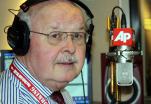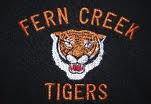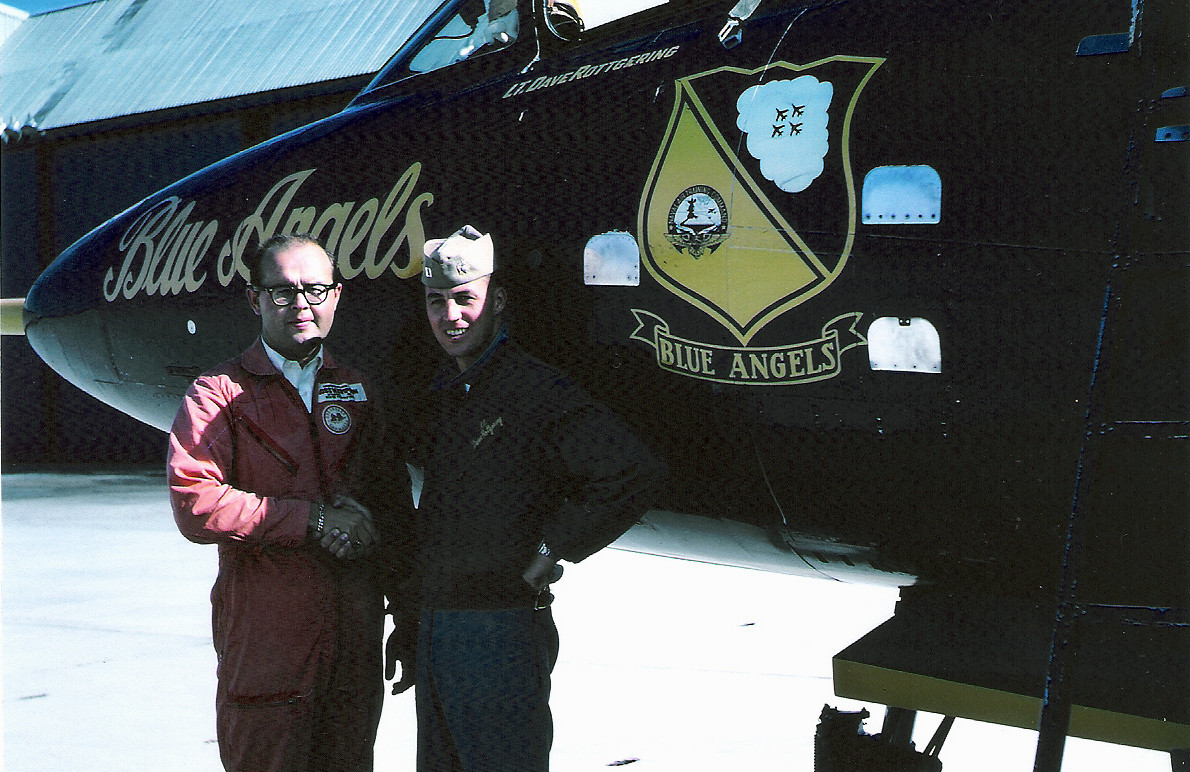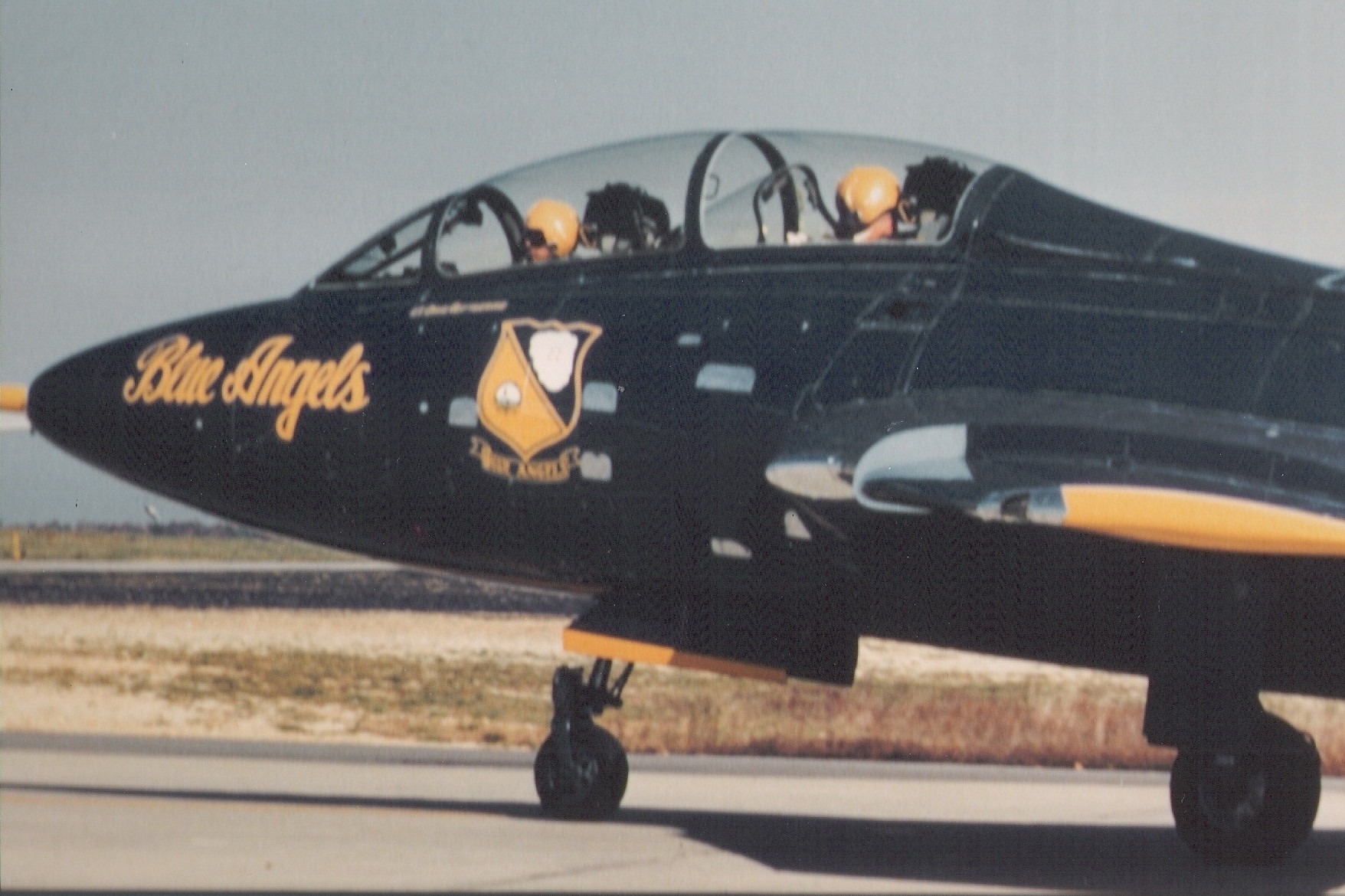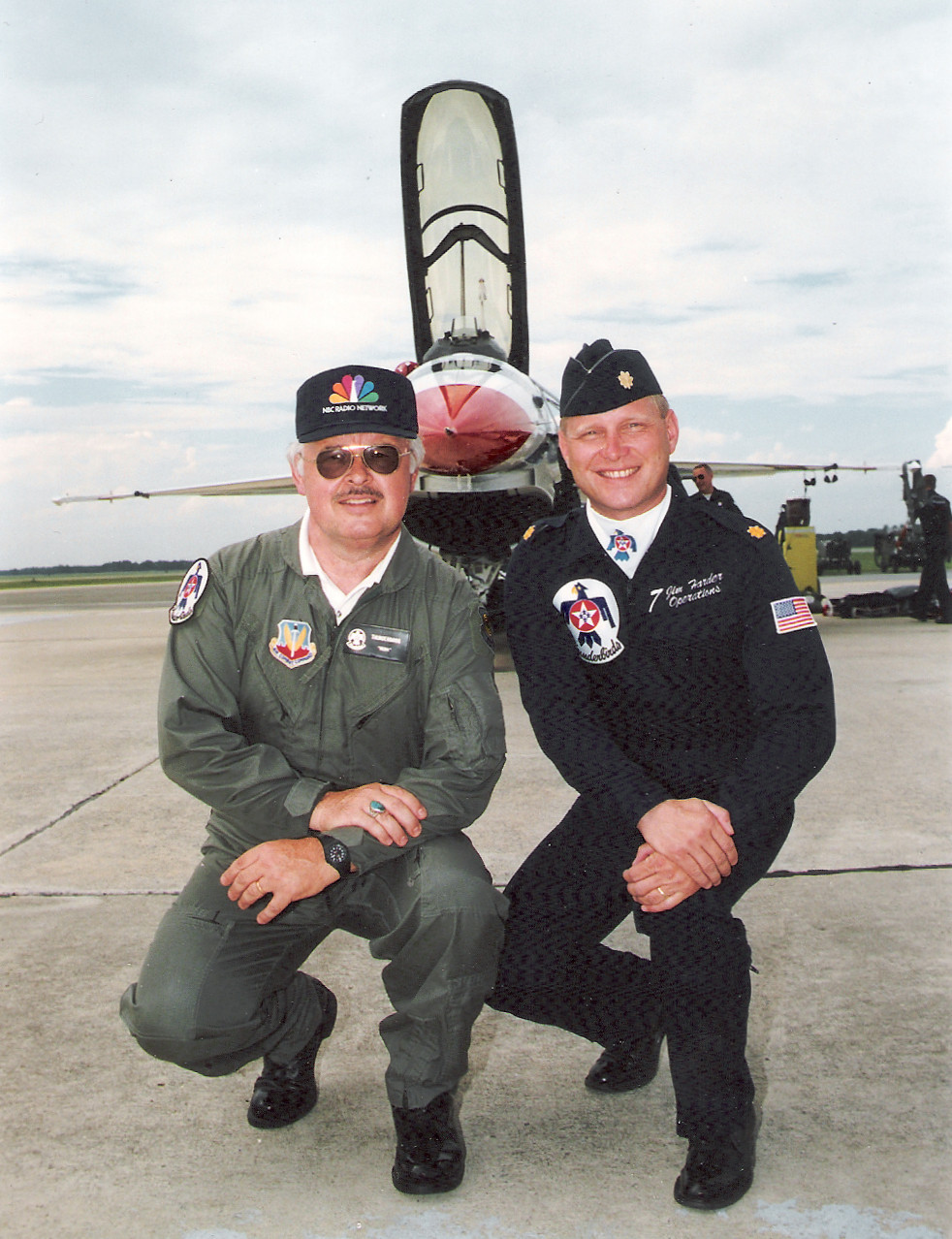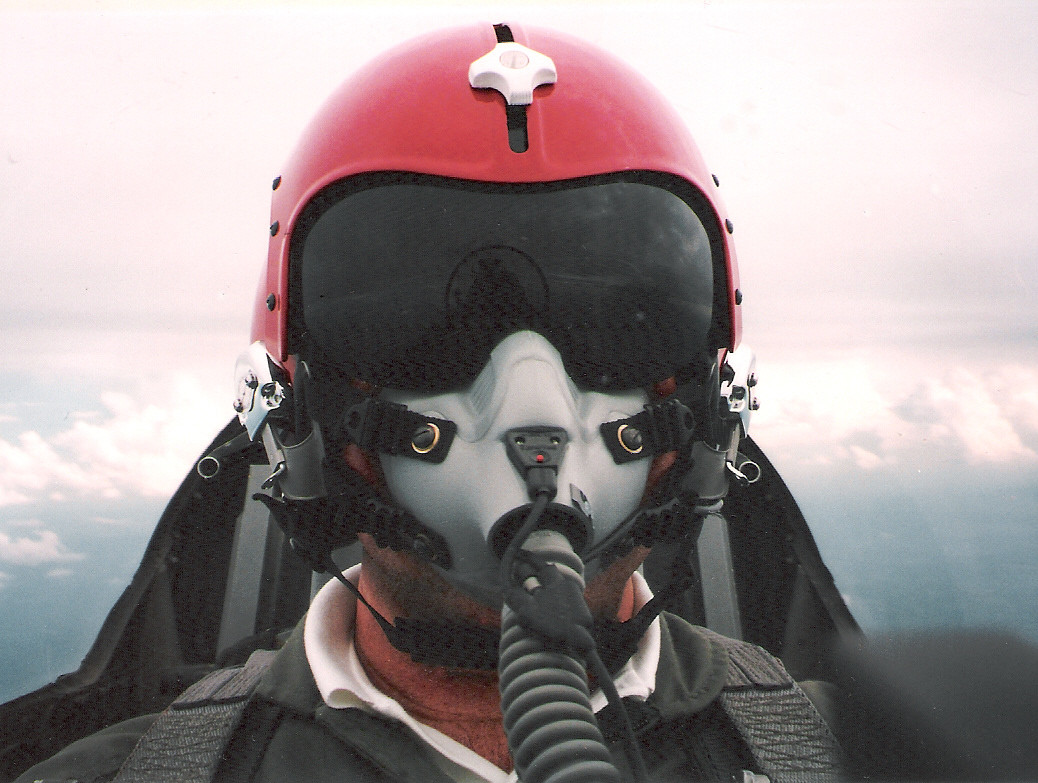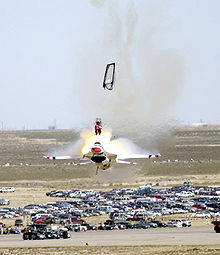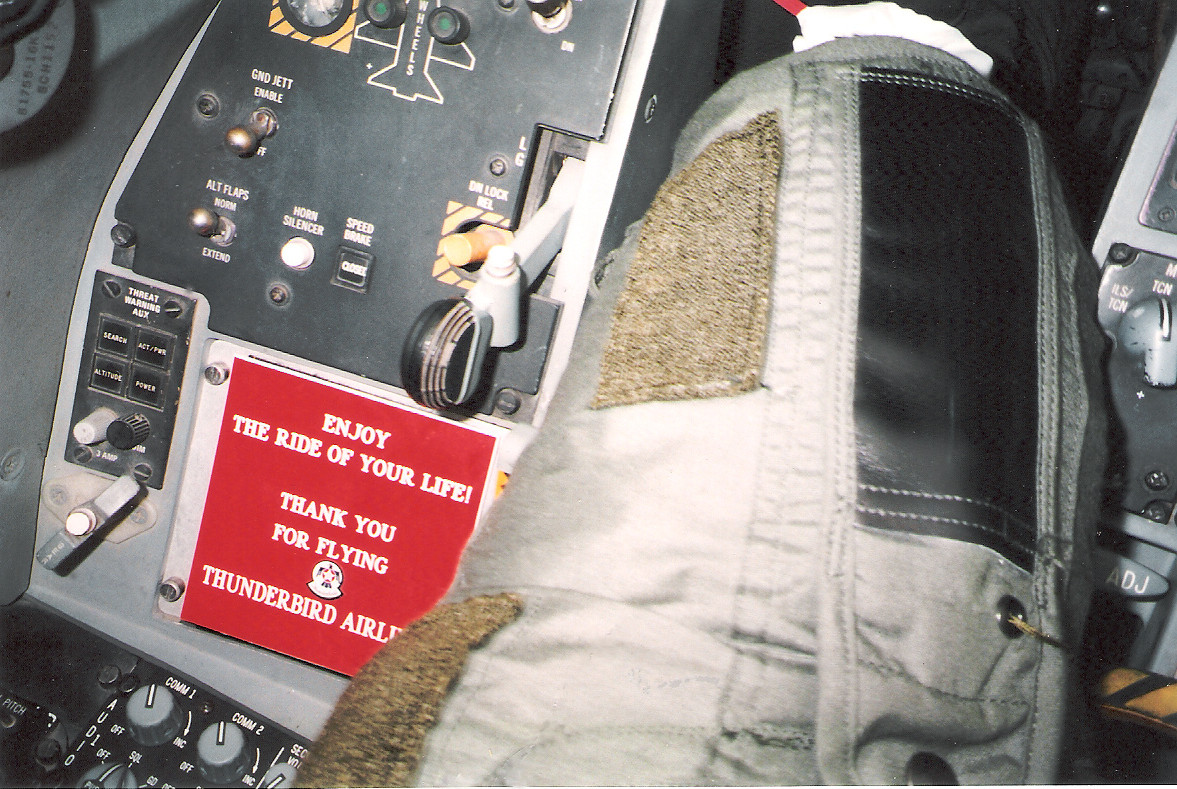Creeker Chronicles
A compendium of anecdotes and stories by
Contributing Editor Ross Simpson
 A ride in the backseat of a Korean War era fighter was all it took to hook me on flying in high-performance jets. The Grumman F9F-2 Panther the most widely-used U.S. Navy jet fighter of the Korean War, flying 78,000 sorties.
A ride in the backseat of a Korean War era fighter was all it took to hook me on flying in high-performance jets. The Grumman F9F-2 Panther the most widely-used U.S. Navy jet fighter of the Korean War, flying 78,000 sorties.
 Many famous pilots flew the Panther in combat: first-man-on-the-moon Neil Armstrong flew the F9F extensively during the war, even ejecting, when his aircraft hit a wire stretched across a valley in Korea. Another astronaut and U. S. senator, John Glenn, and Boston Red Sox Hall of Fame outfielder Ted Williams also flew the Panther during the Korean War.
Many famous pilots flew the Panther in combat: first-man-on-the-moon Neil Armstrong flew the F9F extensively during the war, even ejecting, when his aircraft hit a wire stretched across a valley in Korea. Another astronaut and U. S. senator, John Glenn, and Boston Red Sox Hall of Fame outfielder Ted Williams also flew the Panther during the Korean War.
 The two-seat variant of the F9F-2 in which I flew in 1967 was the photo plane for the Navy Blue Angels, the oldest flying aerobatic team, first formed in 1946, a year before the Panther made its maiden flight.
The two-seat variant of the F9F-2 in which I flew in 1967 was the photo plane for the Navy Blue Angels, the oldest flying aerobatic team, first formed in 1946, a year before the Panther made its maiden flight.
 I was working as a cameraman-reporter for the CBS-TV affiliate in Washington, D.C. when my boss asked if I wanted to fly with the “Blues.” Only three members of the media were selected to fly with the Blue Angels, who were in town for an air show.
I was working as a cameraman-reporter for the CBS-TV affiliate in Washington, D.C. when my boss asked if I wanted to fly with the “Blues.” Only three members of the media were selected to fly with the Blue Angels, who were in town for an air show.
 It was a cool, crisp morning when I donned an orange flight suit and reported to Andrews Air Force Base, Maryland where I had spent almost two years in the TV center at USAF Systems Command.
It was a cool, crisp morning when I donned an orange flight suit and reported to Andrews Air Force Base, Maryland where I had spent almost two years in the TV center at USAF Systems Command.
 I had flown to Alaska and the Philippines and back in lumbering propeller-driven cargo planes, but had never flown in a jet fighter. The pilot was Lieutenant Dave Rottgering, a graduate of Western Kentucky. We hit it off right away.
I had flown to Alaska and the Philippines and back in lumbering propeller-driven cargo planes, but had never flown in a jet fighter. The pilot was Lieutenant Dave Rottgering, a graduate of Western Kentucky. We hit it off right away.
 The Panther had already had its pre-flight preparations when I arrived at plane side. The crew chief buckled me into rear seat and showed me the ejection handles, in case of an in-flight emergency.
The Panther had already had its pre-flight preparations when I arrived at plane side. The crew chief buckled me into rear seat and showed me the ejection handles, in case of an in-flight emergency.
 “Clear,” yelled Rottgering, as he flipped a toggle switch and started the engine with the help of an auxiliary power unit, connected to the Panther jet with a long black cable.
“Clear,” yelled Rottgering, as he flipped a toggle switch and started the engine with the help of an auxiliary power unit, connected to the Panther jet with a long black cable.
 As we taxied to the main runway, I heard Lt. Rottgering talking to Andrews approach.
As we taxied to the main runway, I heard Lt. Rottgering talking to Andrews approach.
 “Andrews, This is Angel-7,” said Rottgering, as he touched the left brake pedal and turned the aircraft onto Runway 21 for takeoff.
“Andrews, This is Angel-7,” said Rottgering, as he touched the left brake pedal and turned the aircraft onto Runway 21 for takeoff.
 Pointed down the runway, Rottgering locked both brakes and ran the engine to “military power.” The Panther shook like an angry animal chained to a stake.
Pointed down the runway, Rottgering locked both brakes and ran the engine to “military power.” The Panther shook like an angry animal chained to a stake.
 “Here we go,” said Dave as he released the brakes and the Panther lunged forward.
“Here we go,” said Dave as he released the brakes and the Panther lunged forward.
 Halfway down the runway, I felt the nose lift off the ground and the wheels retract with a THUMP under the wings. We were airborne. All I could hear was wind rushing past the canopy as we climbed out of Andrews and headed toward the Chesapeake Bay.
Halfway down the runway, I felt the nose lift off the ground and the wheels retract with a THUMP under the wings. We were airborne. All I could hear was wind rushing past the canopy as we climbed out of Andrews and headed toward the Chesapeake Bay.
 Leveling off at 5,000 feet, I could see the choppy water ahead, sparkling like a million diamonds in the sunlight.
Leveling off at 5,000 feet, I could see the choppy water ahead, sparkling like a million diamonds in the sunlight.
 “Are you ready to do a few aerial maneuvers?” Dave asked over the aircraft’s intercom.
“Are you ready to do a few aerial maneuvers?” Dave asked over the aircraft’s intercom.
 “Ready,” I replied into my lip mike. “Show me what you can do,” I replied boldly.
“Ready,” I replied into my lip mike. “Show me what you can do,” I replied boldly.
 Rottgering was wearing a G-harness, to counteract the crushing effects of gravity on his body. It’s a canvas pair of inflatable chaps that fit tightly around the legs, with a rubber bladder that stretches across your abdomen. An umbilical-like hose hangs down the left leg and, when connected to a fitting in the cockpit, it will automatically inflate when it senses a change in gravity. The G-Harness restricts the flow of blood rushing from the brain to your toes in a steep dive or climb.
Rottgering was wearing a G-harness, to counteract the crushing effects of gravity on his body. It’s a canvas pair of inflatable chaps that fit tightly around the legs, with a rubber bladder that stretches across your abdomen. An umbilical-like hose hangs down the left leg and, when connected to a fitting in the cockpit, it will automatically inflate when it senses a change in gravity. The G-Harness restricts the flow of blood rushing from the brain to your toes in a steep dive or climb.
 I wasn’t wearing a G-Harness and almost blacked out when he snapped the Panther onto its side in a tight turn. I raised the sunshield on my helmet and looked into the rear view mirrors attached to the rim of the windscreen. My eyes began to sag and my vision began to fade to a pinhole as we pulled between 3-4 G’s. My 200 pound body suddenly felt like it weighed 800 pounds.
I wasn’t wearing a G-Harness and almost blacked out when he snapped the Panther onto its side in a tight turn. I raised the sunshield on my helmet and looked into the rear view mirrors attached to the rim of the windscreen. My eyes began to sag and my vision began to fade to a pinhole as we pulled between 3-4 G’s. My 200 pound body suddenly felt like it weighed 800 pounds.
 The force of gravity on the human body during fighter maneuvers is often described as an elephant sitting on your chest. To keep alive, I began grunting like a bear and sucking oxygen like a scuba diver.
The force of gravity on the human body during fighter maneuvers is often described as an elephant sitting on your chest. To keep alive, I began grunting like a bear and sucking oxygen like a scuba diver.
 “Are you alright back there,” asked Dave.
“Are you alright back there,” asked Dave.
 “Yeaaaaah,” I replied as I fought the urge to lose my breakfast in the barf bag the crew chief had tucked into the pocket on the sleeve of my flight suit.
“Yeaaaaah,” I replied as I fought the urge to lose my breakfast in the barf bag the crew chief had tucked into the pocket on the sleeve of my flight suit.
 As we flew the length of the Chesapeake Bay, we could see duck hunters in their blinds.
As we flew the length of the Chesapeake Bay, we could see duck hunters in their blinds.
 “Watch this,” laughed Dave, as he pulled the Panther into the sun, flipped over on its back, and dove at a row of blinds. I saw several ducking duck hunters as we roared past them at almost 600 miles per hour, followed by a victory roll as we rocketed out of sight.
“Watch this,” laughed Dave, as he pulled the Panther into the sun, flipped over on its back, and dove at a row of blinds. I saw several ducking duck hunters as we roared past them at almost 600 miles per hour, followed by a victory roll as we rocketed out of sight.
 Lt. Rottgering was the public address announcer for the Blue Angels in 1967. He was the person who told crowds at air shows what to expect when a tight diamond formation of blue jets came into view; but he was also an aviator capable of flying the “slot,” the trailing position.
Lt. Rottgering was the public address announcer for the Blue Angels in 1967. He was the person who told crowds at air shows what to expect when a tight diamond formation of blue jets came into view; but he was also an aviator capable of flying the “slot,” the trailing position.
 Less than a year after we flew together on the east coast, he rejoined the fleet on the west coast. Dave was flying a training mission near Yuma, Arizona in February 1968 when his Crusader fighter-bomber went into an uncontrollable spin and he had to eject.
Less than a year after we flew together on the east coast, he rejoined the fleet on the west coast. Dave was flying a training mission near Yuma, Arizona in February 1968 when his Crusader fighter-bomber went into an uncontrollable spin and he had to eject. 
 Ejections can be life-threatening episodes, but Lt. Rottgering survived, completed a combat tour over North Vietnam and returned stateside unscathed. After a life of service for his country, Lieutenant Commander Dave Rottgering died at age 60. He was buried with full military honors alongside other Blue Angels, in a special section of the military cemetery at Pensacola (Florida) Naval Air Station, the home of naval aviators.
Ejections can be life-threatening episodes, but Lt. Rottgering survived, completed a combat tour over North Vietnam and returned stateside unscathed. After a life of service for his country, Lieutenant Commander Dave Rottgering died at age 60. He was buried with full military honors alongside other Blue Angels, in a special section of the military cemetery at Pensacola (Florida) Naval Air Station, the home of naval aviators.
Blues To Birds
 The Navy Blue Angels and the Air Force Thunderbirds allow a few civilians to fly with them each year, but it is rare for a member of the media to fly with both aerial demonstration teams.
The Navy Blue Angels and the Air Force Thunderbirds allow a few civilians to fly with them each year, but it is rare for a member of the media to fly with both aerial demonstration teams.
 I was 25 years old when I flew with the “Blues.” I was 55 when I flew with the “Birds.” The fighter-bomber in 1967 had a top speed of 575 miles per hour. The one in 1996 had a top speed of Mach 2, twice the speed of sound, about 1,500 miles per hour.
I was 25 years old when I flew with the “Blues.” I was 55 when I flew with the “Birds.” The fighter-bomber in 1967 had a top speed of 575 miles per hour. The one in 1996 had a top speed of Mach 2, twice the speed of sound, about 1,500 miles per hour.
 I flew with the Thunderbirds the day before they lit up the night sky over Olympic Stadium in Atlanta, during opening ceremonies for the 1996 Summer Olympics.
I flew with the Thunderbirds the day before they lit up the night sky over Olympic Stadium in Atlanta, during opening ceremonies for the 1996 Summer Olympics. 
 Working for NBC, which was broadcasting the games on radio and television, helped get me a ride in the backseat of Number 7, a F-16D Fighting Falcon that served as the photo plane; but knowing the brigadier general in charge of Air Force Public Affairs at the Pentagon was the biggest plus. As a Colonel in Panama, he arranged for me to fly a combat mission with Spectre, an AC-130 gunship crew, on New Year’s Eve, 1989 as U.S. forces searched for ousted dictator Manuel Noriega.
Working for NBC, which was broadcasting the games on radio and television, helped get me a ride in the backseat of Number 7, a F-16D Fighting Falcon that served as the photo plane; but knowing the brigadier general in charge of Air Force Public Affairs at the Pentagon was the biggest plus. As a Colonel in Panama, he arranged for me to fly a combat mission with Spectre, an AC-130 gunship crew, on New Year’s Eve, 1989 as U.S. forces searched for ousted dictator Manuel Noriega.
 After suiting up and being briefed at Warner-Robbins AFB in Georgia, I walked to the red, white and blue jet for some photos, including the classic Thunderbird pose in front of the aircraft with the pilot. Climbing upon the left wing for another photo, I noticed that the crew chief had painted my name on the canopy. Nice touch.
After suiting up and being briefed at Warner-Robbins AFB in Georgia, I walked to the red, white and blue jet for some photos, including the classic Thunderbird pose in front of the aircraft with the pilot. Climbing upon the left wing for another photo, I noticed that the crew chief had painted my name on the canopy. Nice touch.
 When I flew with the Blue Angels almost 30 years earlier, I received no training on the ejection seat, but before flying with the Thunderbirds, I was thoroughly instructed on the ejection seat, capable of blasting a pilot through the canopy, if necessary, on the ground.
When I flew with the Blue Angels almost 30 years earlier, I received no training on the ejection seat, but before flying with the Thunderbirds, I was thoroughly instructed on the ejection seat, capable of blasting a pilot through the canopy, if necessary, on the ground.
 Punching out of an aircraft is hazardous to your health. I read that more than half of pilots who eject from “fast movers” like the F-16 are killed and almost another third are seriously injured. That information rattled around in my helmet as the crew chief leaned into the rear cockpit and pointed out the ejection handle and stressed the need to keep my boots in the steel stirrups in case we had to eject. If I didn’t, he said, there’s a good chance my legs will be severed at the knees if they hit the instrument panel on the way out. He also pointed to a red flag attached to a pin.
Punching out of an aircraft is hazardous to your health. I read that more than half of pilots who eject from “fast movers” like the F-16 are killed and almost another third are seriously injured. That information rattled around in my helmet as the crew chief leaned into the rear cockpit and pointed out the ejection handle and stressed the need to keep my boots in the steel stirrups in case we had to eject. If I didn’t, he said, there’s a good chance my legs will be severed at the knees if they hit the instrument panel on the way out. He also pointed to a red flag attached to a pin.
 “Pull that pin just before the pilot lowers the canopy,” he said, “and your seat is armed. Don’t forget to re-insert the pin after you land and he raises the canopy. Otherwise we might have to scrape you off the tarmac,” he laughed.
“Pull that pin just before the pilot lowers the canopy,” he said, “and your seat is armed. Don’t forget to re-insert the pin after you land and he raises the canopy. Otherwise we might have to scrape you off the tarmac,” he laughed.
 Unlike other jet fighters, the pilot and back seat passenger in an F-16D recline in their ejection seats at a 30-degree angle. That eases the effects of high G-forces.
Unlike other jet fighters, the pilot and back seat passenger in an F-16D recline in their ejection seats at a 30-degree angle. That eases the effects of high G-forces.
 This time, I was wearing a G-Harness, a fireproof flight suit and gloves; but, I didn’t have a clue as to what was about to happen when the pilot released the brakes, ignited the afterburner and hurtled down the runway at Warner-Robbins.
This time, I was wearing a G-Harness, a fireproof flight suit and gloves; but, I didn’t have a clue as to what was about to happen when the pilot released the brakes, ignited the afterburner and hurtled down the runway at Warner-Robbins.
 As the gear came up, the pilot went ballistic, as he pointed the nose of the straight up. The force of gravity from this maneuver is the same as shuttle astronauts experience when they launch.
As the gear came up, the pilot went ballistic, as he pointed the nose of the straight up. The force of gravity from this maneuver is the same as shuttle astronauts experience when they launch.
 “Look over your shoulder,” said Major Jim Hardin, as the airfield rapidly disappeared below us. At 35,000 feet, he flipped the jet onto its back. I hung in the shoulder straps, helmet resting against the canopy and looked straight down as we went negative-G. In that condition, you’re weightless and anything in the cockpit that’s not secured will float free, including the Minolta point and shoot camera in my lap.
“Look over your shoulder,” said Major Jim Hardin, as the airfield rapidly disappeared below us. At 35,000 feet, he flipped the jet onto its back. I hung in the shoulder straps, helmet resting against the canopy and looked straight down as we went negative-G. In that condition, you’re weightless and anything in the cockpit that’s not secured will float free, including the Minolta point and shoot camera in my lap.
 Leveling off, Hardin said, “Take the stick. It’s yours. Uncle Sam and the American taxpayer have given you one hour of free time to set your hair on fire.” Because we were flying in a military operating area, we weren’t able to go supersonic, but we did so some “turnin’ and burnin’.”
Leveling off, Hardin said, “Take the stick. It’s yours. Uncle Sam and the American taxpayer have given you one hour of free time to set your hair on fire.” Because we were flying in a military operating area, we weren’t able to go supersonic, but we did so some “turnin’ and burnin’.”
 “Do you want to earn the Black Diamond today,” inquired Hardin.
“Do you want to earn the Black Diamond today,” inquired Hardin.
 “What’s that?” I asked.
“What’s that?” I asked.
 “It’s 9Gs,” he said.
“It’s 9Gs,” he said.
 I know what flying 4Gs can do to you. It strains every muscle in your body as you grunt to stay conscious and for weeks you can’t bend over to tie your shoes or wash your face in the sink. I could only imagine what 9Gs would do, so I declined. I was part of NBC’s broadcast team at the Summer Olympics and didn’t want to be hurting all over.
I know what flying 4Gs can do to you. It strains every muscle in your body as you grunt to stay conscious and for weeks you can’t bend over to tie your shoes or wash your face in the sink. I could only imagine what 9Gs would do, so I declined. I was part of NBC’s broadcast team at the Summer Olympics and didn’t want to be hurting all over.
 The F-16 is a fly-by-wire jet, which means it flies wherever you point it. Flying an F-16 is like playing a video game. The stick is located on a control panel next to your right knee. The slightest movement of the stick will cause the jet to climb, dive or flip.
The F-16 is a fly-by-wire jet, which means it flies wherever you point it. Flying an F-16 is like playing a video game. The stick is located on a control panel next to your right knee. The slightest movement of the stick will cause the jet to climb, dive or flip.
 The night before, I read a book about aerial maneuvers, so when the pilot asked me to execute a four-point roll, I had no problem.
The night before, I read a book about aerial maneuvers, so when the pilot asked me to execute a four-point roll, I had no problem.
 “You’ve flown before, haven’t you?” he asked.
“You’ve flown before, haven’t you?” he asked.
 “Yes, but I read a book last night about what aerial demonstration teams like the Thunderbirds do.”
“Yes, but I read a book last night about what aerial demonstration teams like the Thunderbirds do.”
 He laughed, “You’ve got to be kidding. We train for years to be able to do these maneuvers and you’ve mastered them by reading a book!”
He laughed, “You’ve got to be kidding. We train for years to be able to do these maneuvers and you’ve mastered them by reading a book!”
 I decided to show off and pulled the jet into a vertical climb, went negative-G as we came over the top of the climb, and kicked in the smoke as we roared down the backside. The author of the book had written that if you pick a scratch on the canopy and cut the smoke trail with it, you can fly a perfect circle.
I decided to show off and pulled the jet into a vertical climb, went negative-G as we came over the top of the climb, and kicked in the smoke as we roared down the backside. The author of the book had written that if you pick a scratch on the canopy and cut the smoke trail with it, you can fly a perfect circle.
 The pilot couldn’t believe a civilian with only a few hours of stick time in his logbook could do what I had just done.
The pilot couldn’t believe a civilian with only a few hours of stick time in his logbook could do what I had just done.
 Near the end of the hour, he said it was time to drive the aircraft through Mother Nature’s car wash and take it back to Warner-Robbins. I eased the control stick back and pointed us toward a big thunderhead in the distance. It was a thrill to drill a hole in a massive cloud formation and watch the condensation streak off the clear glass bubble canopy.
Near the end of the hour, he said it was time to drive the aircraft through Mother Nature’s car wash and take it back to Warner-Robbins. I eased the control stick back and pointed us toward a big thunderhead in the distance. It was a thrill to drill a hole in a massive cloud formation and watch the condensation streak off the clear glass bubble canopy.
 Sometime after my flight with the Thunderbirds, the Department of Defense changed the rules. Due to a couple of mishaps, civilians are no longer permitted to fly high-performance jet fighters.
Sometime after my flight with the Thunderbirds, the Department of Defense changed the rules. Due to a couple of mishaps, civilians are no longer permitted to fly high-performance jet fighters.
 Anyone who flies with the aerial demonstration teams is presented an autographed lithograph of the team in action. I was also given flight certificates and insignia, from both the Blues and the Birds, that I proudly wear on one of four flight jackets that I have acquired over 43 years of “flying high and fast with the finest.”
Anyone who flies with the aerial demonstration teams is presented an autographed lithograph of the team in action. I was also given flight certificates and insignia, from both the Blues and the Birds, that I proudly wear on one of four flight jackets that I have acquired over 43 years of “flying high and fast with the finest.”
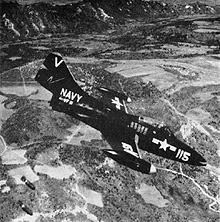
Grumman F9F-2 Panther drops two 500 pound bombs over North Korea.
Ross with Lt. Dave Rottgering, after their
flight from Andrews Air Force Base, Maryland.
On the taxiway, just before takeoff in Blue Angels aircraft
Ross Simpson with Major Joe Hardin
of the Air Force Thunderbirds
Ross Simpson, self-portrait.
Ross witnessed this unplanned ejection by a Thunderbird pilot. This pilot survived, but years earlier, Ross saw a similar Thunderbird ejection in which the pilot was killed before the eyes of a stunned Dulles Airport crowd.
Next to Ross's leg, the red plaque reads,"ENJOY THE RIDE OF YOUR LIFE. THANK YOU FOR FLYING THUNDERBIRD AIRLINES.
Hitching a Ride With the Navy Blue Angels and the Air Force Thunderbirds takes connections and good timing. Ross Simpson had both and had rides to remember.
